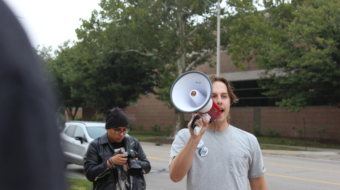
Recently House Resolution 1 (H.R.1) passed in congress cutting $60 billion from the federal budget. One of the programs hit hardest is the Pell Grant program which was stripped of $5.7 billion. Pell Grants provide financial assistance to working class youth who are attempting to get a degree and better themselves, at the same time bettering the economy and society. The benefits will now be capped at $4705 a year – taking almost a thousand dollar hit to what barely covered costs of tuition and books in most schools as it was. Even more troubling is the proposal to make 1.7 million students who receive smaller grants now totally ineligible for the program.
Jason Grau is like many of the students who rely on the Pell Grant program: all trying to turn their everyday struggle of paying their bills and building a life for themselves and their families into more manageable and fulfilling live. Jason, a 27 year old father from Shrewsbury Penn. is currently attending college in the mornings in between taking care of his son (who will be turning 6 in June) and then driving to Baltimore City to work at a bar 6 days a week (usually until 3 a.m.) and then back home to Pennsylvania to start the whole cycle again.
These students are working class kids who want to make a larger contribution to society than their current education and financial situations allow. And they simply want to make the lives of their children better than their own.
Jason, student and father by day, bartender and amateur rapper by night knew nothing of the cuts to the Pell Grant program. When I brought it up a look of horror came to his face. “I don’t get enough money from my federal loan to support my education without it, and I probably wouldn’t get approved for the loan so I would probably not be able to go to school anymore. Or I’d have to somehow make more money which is why I need a degree in the first place!” he added sarcastically.
President Obama countered the GOP proposed cuts by reminding Americans of his own success story with federal student assistance programs saying, “How many of you who are in the audience have gotten a Pell Grant to help you pay your way? How many of you can’t afford to pay another $1,000 to go to school? I know what this is like, scholarships helped make it possible for me and for Michelle to go to college. It’s fair to say I wouldn’t be president if it hadn’t been for somebody helping me be able to afford college. That’s why I think it would be such a huge mistake to balance the budget on the backs of students, by cutting scholarships by as much as $1,000, forcing students to go without them altogether.”
The fight back on campuses
Students and student organizations aren’t taking the attack sitting down. The U.S. Student Association is concentrating their efforts on the Senate to convince them to correct the House of Representatives passing of the cuts. Lindsay McClusky, president of the U.S. Student Association wrote, “Where the House failed, the Senate now has a golden opportunity to express the crystal clear view of the American people, and especially that of America’s youth.” in an article addressing the issue on the organization’s webpage. Adding “Rare is the political issue that is politically popular, bipartisan, and the right thing to do. The Senate must pass a budget that takes advantage of this golden opportunity.”
You can find their campaign “Where’s The Funding?” or “WTF?” here . There you can also find a detailed list of the cuts, a copy of the GOP Ryan bill and the organization’s response to it. And there is information on how to act both locally and on campus calling on students to start their own “WTF?” campaign on their campus. The focus of the campaign in the short term is mandatory funding of the Pell Grant program, and making higher education a right in the United States.
At the Cheyney University in Pennsylvania, the University of Wisconsin, Madison, (where they are fighting Governor Scott Walker’s attempts to privatize the public university system), Central Florida, UCLA, and the University of Washington, from coast to coast students are taking actions to stand up to their right to an education. And there is the Oregon Student Association who, along with thousands of protesters marched to lobby their representatives. And, the students at Rutgers who occupied one of the University’s historic sites in protest.
Students fighting cuts at the local level
The attack on education doesn’t stop at the cuts to the Pell Grant system. All over the country the new field of conservative governors and state governments are cutting education budgets and turning on teachers. Local governments are slashing funding to our schools by the millions and even grade school students are fighting back. April 29th in Nevada hundreds of high-school students recently took to the strip in Las Vegas to protest a proposed $400 million cut from the Clark County school budget. Armed with signs saying “Don’t Gamble with my Education” and “Save my Education” the students collected signatures for a petition for funding.
All over Texas hundreds of high-school students participated in a walk-out April 29th over teacher lay-offs in a recently passed Republican budget. The police have used the opportunity to issue tickets for disrupting class by protesting. As long as these attacks on students and young people continue so will these types of responses all over the country.
While the GOP claim that these types of cuts will somehow secure a better future for future generations by relieving them of debt, how can robbing more than a million young people of an education – that in so many other countries is their right – be considered a favor? With their arsenal of talking points about job killing programs and competition how are we expected to compete with countries like Norway, Denmark and Finland who enjoy much higher standards of living and stronger economies as a result of their free education system? How can we even hope to compete with future contenders like Argentina and even Sri Lanka who guarantee free education at all levels?
Students don’t have billions of dollars or even the right to vote until they are 18, and even then the right-wing goes to every expense and effort to prevent students from being able to vote. Through bills like the one in Wisconsin (recently defeated) that would not allow student IDs as valid identification at a polling place, and ongoing attempts to generate voter apathy, the right wing constantly attempts to silence student’s voices. But what students do have is energy, passion and power in numbers.
Write to your Senator, organize an action in solidarity!
If our regularly ignored constituency can stand together like the students of the UK last winter, we too could gain not only the attention of our leaders but the eyes and ears of the world.
Photo: A working college student and father spending time with his son. Like many others who want to make a larger contribution to society than their current education and financial situations allow, they simply want to make the lives of their children better than their own. People’s World










